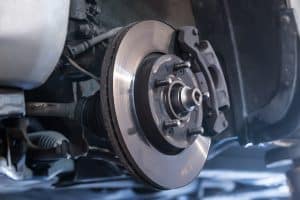Automatic Emergency Braking Systems to Be Required on Semi-Trucks
 Automatic Emergency Braking (AEB) is a cutting-edge safety technology that has been gaining significant traction in the automotive industry, and its application is not limited to passenger vehicles alone. AEB is also playing a crucial role in enhancing safety for semi-trucks and other commercial vehicles. Advocates for this technology have been fighting for its regulated installation into all commercial vehicles, and up until now, it has not been widely required.
Automatic Emergency Braking (AEB) is a cutting-edge safety technology that has been gaining significant traction in the automotive industry, and its application is not limited to passenger vehicles alone. AEB is also playing a crucial role in enhancing safety for semi-trucks and other commercial vehicles. Advocates for this technology have been fighting for its regulated installation into all commercial vehicles, and up until now, it has not been widely required.
A June proposal issued by the National Highway Traffic Safety Administration and the Federal Motor Carrier Safety Administration would require that most new Class 7 and 8 trucks (those with a weight rating of over 26,000 pounds) have AEB systems integrated within three years of the final rule, and for most new Class 3-6 trucks (weighing over 10,000 pounds) to meet the requirements within four years.
A growing body of evidence highlights the significant advantages of utilizing AEB in Class 7 & 8 trucks. According to the Institute for Safer Trucking, various studies indicate that AEB could potentially prevent 31–37 percent of heavy vehicle front-to-rear crashes, leading to a remarkable reduction of 26,000–31,000 crashes, 2,000–3,000 fewer injuries, and 98–115 fewer fatalities. The NHTSA also estimates that implementing AEB in large trucks could prevent up to 11,499 crashes, 7,703 injury crashes, and 173 fatal crashes annually.
Moreover, real-world data supports these findings, as heavy vehicles equipped with AEB were involved in 20.7 percent fewer front-to-rear crashes compared to those without this technology. Trucking companies that have adopted AEB have reported remarkable reductions in rear-end collisions, with incidents dropping significantly by 69 to 71 percent. These compelling statistics underscore the potential life-saving and injury-preventing impact of AEB in the context of commercial trucking, making it a crucial consideration for enhancing road safety in the industry.
How does automatic emergency braking work?
In essence, AEB is a collision avoidance system that uses sensors, cameras, and advanced algorithms to detect potential collisions with objects in the vehicle’s path. When a potential collision is identified, the system automatically applies the brakes to either mitigate the impact or bring the vehicle to a complete stop, reducing the severity of the collision or preventing it altogether.
How is AEB beneficial?
For semi-trucks, AEB is proving to be a game-changer in terms of safety. Due to their massive size and weight, semi-trucks have a longer stopping distance compared to passenger vehicles. AEB can help bridge this gap by providing an additional layer of protection and response time that might not always be feasible for human drivers.
One critical aspect of AEB in semi-trucks is its ability to detect vulnerable road users, such as pedestrians, cyclists, and motorcyclists. These individuals are particularly at risk in collisions involving large commercial trucks, and AEB can significantly reduce the chances of such accidents.
Furthermore, AEB can be especially beneficial in situations where truck drivers face challenges like fatigue, distraction, or adverse weather conditions. Human errors account for a significant portion of truck accidents, and AEB acts as a safety net to mitigate the consequences of these errors.
What risks come with AEB?
While AEB holds great promise for improving road safety in the trucking industry, it is important to note that it should not be seen as a substitute for responsible and attentive driving. Proper training for truck drivers in using and understanding AEB technology is vital to ensure its optimal performance and effectiveness. Additionally, regular maintenance and calibration of the AEB system are essential to keep it functioning properly.
Not only should semi-truck operators be aware of the possible risks, but the drivers around them should as well. Drivers should give commercial trucks the appropriate amount of space when driving behind, beside, or in front of the truck. If a motorist follows too closely behind the large vehicle and the AEB initiates suddenly, you very well could find yourself severely injured by rear-ending the truck.
As AEB technology continues to evolve and become more widespread in the commercial trucking sector, it is expected to have a substantial positive impact on reducing the number and severity of accidents involving semi-trucks. This advancement in safety technology marks a significant step towards achieving safer roads and protecting all road users.
Contact our Tulsa attorneys to learn more
At Biby Law Firm, we take great pride in our many successful experiences in handling trucking cases, and will tirelessly advocate for you and your family’s rights. If you have suffered injuries in a truck accident or if you have lost a loved one due to such an incident, our experienced Tulsa truck accident lawyers are here to assist you. Reach out to us today through our contact form or by calling to schedule a free consultation. Remember, we operate on a contingency fee basis, which means you don’t pay unless we win your case.

Jacob Biby has spent his legal career helping folks just like you get the resources they need after a personal injury, car accident, or oil field injury. He completed his undergraduate degree at Oklahoma State University and earned his Juris Doctorate from the University of Tulsa in 2008. Jacob is licensed to practice in all Oklahoma state and federal courts. Learn more about Jacob Biby.

